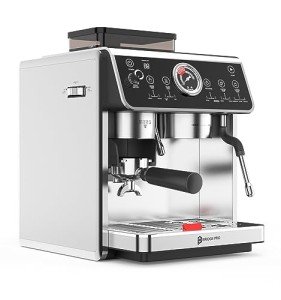Energy-Efficient Espresso Machines: A Comprehensive Guide
In the world of coffee enthusiasts, espresso machines are typically considered as essential appliances for brewing rich, aromatic coffee. However, the energy intake related to these machines can result in increased energy costs and environmental concerns. As consumers end up being more eco-conscious, energy-efficient espresso machines have become a popular option. This article intends to check out the features, advantages, and options offered in energy-efficient espresso machines, helping coffee enthusiasts make informed choices.
What Makes an Espresso Machine Energy-Efficient?
Energy-efficient espresso machines are created to lessen energy intake while keeping optimum performance. Several features contribute to the energy effectiveness of these machines:
- Insulation: High-quality insulation helps keep heat, decreasing the energy required to maintain ideal developing temperatures.
- Smart Technology: Many modern machines are geared up with programmable settings that permit users to schedule brewing times and switch to standby mode when not in use.
- Quick Heat-up Time: Energy-efficient espresso machines typically use advanced heating technologies, such as thermoblocks or PID controllers, to heat water rapidly.
- Low Wattage: Machines that run at lower wattages consume less energy overall, making them more efficient.
- Automobile Shut-off: Automatic shut-off includes ensure that the machine shuts off after a specific duration of lack of exercise, additional decreasing energy waste.
Benefits of Energy-Efficient Espresso Machines
Purchasing an energy-efficient espresso machine can provide numerous advantages:
- Cost Savings: Over time, lower energy consumption can cause reduced electrical energy bills.
- Environmental Impact: Using less energy reduces carbon footprints, making these machines a more sustainable choice for environmentally conscious customers.
- Enhanced Performance: Many energy-efficient models also provide superior brewing technologies, leading to better-tasting espresso.
- Durability: Typically, energy-efficient machines are developed with high-quality elements, leading to higher longevity.
Features to Consider
When picking an energy-efficient espresso machine, a number of functions ought to be considered:
- Type of Machine: Options include manual, semi-automatic, and completely automatic models, each with varying degrees of user control and automation.
- Brew Quality: Look for machines that use high-quality developing systems to guarantee optimal taste extraction.
- Upkeep: Some machines have self-cleaning functions that can conserve energy and effort in maintenance.
- Capacity: Depending on personal or family size, machine capability can impact energy consumption, with bigger machines frequently needing more power.
Popular Energy-Efficient Espresso Machines
The market offers a range of energy-efficient espresso machines dealing with various needs and preferences. Below are some significant designs:
| Brand | Model | Key Features | Energy Consumption |
|---|---|---|---|
| Breville | Barista Express | Integrated grinder, PID temperature control, fast heat-up. | Low |
| DeLonghi | EC155 | Compact size, simple to use, durable develop. | Moderate |
| Rancilio | Silvia | Durable style, excellent temperature level stability, and has a low ecological impact. | Moderate |
| Gaggia | Timeless | Dependable manual operation, long lasting brass parts, and efficient steaming capability. | Low |
| Jura | E8 | Completely automatic, smart features, and a removable brew group for easy cleansing. | Low |
Tips for Optimal Energy Efficiency
Aside from selecting an energy-efficient design, customers can adopt a number of practices to make the most of energy effectiveness:
- Preheat: If your machine has a pre-heating function, use it to ensure that the optimum temperature is reached quickly before brewing.
- Shut off After Use: Always switch off the machine after developing or make use of machines with auto shut-off features.
- Routine Maintenance: Keep the machine properly maintained to ensure it operates efficiently and efficiently.
FAQs About Energy-Efficient Espresso Machines
1. Are energy-efficient espresso machines more costly?
While the initial investment might be higher for energy-efficient models, the long-lasting savings on electrical energy expenses can offset the initial cost. In addition, many energy-efficient machines come with sophisticated functions that boost the brewing experience.
2. How do I understand if an espresso machine is energy-efficient?
Try to find indications such as Energy Star certification, user reviews, and specs regarding wattage and heat-up time. Buy Coffee Machine with particular features focused on reducing energy consumption are normally designed for better effectiveness.
3. Can I use an energy-efficient espresso machine for other coffee designs?
Many energy-efficient espresso machines use adaptability, allowing users to brew various coffee styles beyond espresso, such as lattes and cappuccinos, by including steaming capabilities.
4. Do energy-efficient models compromise quality for effectiveness?
Not necessarily. Lots of energy-efficient espresso machines are equipped with high-quality brewing innovation that can improve flavor extraction while decreasing energy usage.
5. What maintenance is required for energy-efficient espresso machines?
Regular maintenance involves cleaning up the machine, descaling when needed, and regularly inspecting seals and gaskets to make sure ideal performance and energy effectiveness.
Energy-efficient espresso machines represent a best mix of efficiency, cost savings, and environmental duty. By thinking about numerous functions, advantages, and brand names, consumers can choose a design that matches their special preferences while contributing positively to the environment. As the pattern towards sustainable living grows, the popularity of energy-efficient devices, including espresso machines, is most likely to continue its upward trajectory, using coffee enthusiasts a guilt-free method to enjoy their day-to-day dose of espresso.

